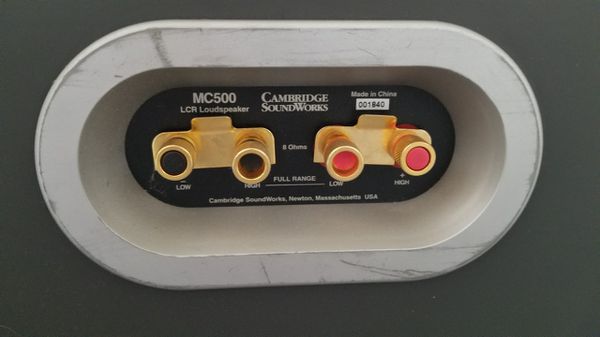

It can play loud and handle explosions and other dynamic sound effects with ease.
Cambridge soundworks mc500 series#
Based on the sound of the MC300 center-channel, using another two of those as L/Rs with a $999.99 Newton P1000 subwoofer might sound better while saving you some money.Īs a complete full-range system for just over $3000, the Cambridge SoundWorks Newton Series T500 offers a great deal in terms of design, bass extension, and dynamics. Better to be soft, rolled-off, and indistinct than bright, hashy, and spitty-especially given the Newton Series' prodigious, reasonably well-controlled bottom end, which extended to below 30Hz. Once my ears had acclimated to the CSW system, the problems, while still obvious, were not as objectionable as sins of commission can be. The problems I've noted were mostly sins of omission. Thanks to its vertically arrayed midrange and tweeter, the MC500 covered a wide listening angle evenly, and couldn't be faulted in terms of vocal clarity and comprehensibility. Sibilance, as you might imagine, wasn't a problem, given the dark overall sound.

Cambridge soundworks mc500 free#
For whatever reasons, the MC500 center-channel seemed to provide a better overall tonal balance and resolve more detail than the Towers, with male and female voices free of telltale response aberrations such as chestiness or boominess. Thanks to its configurable S300 surround speakers, the Newton Series performed well spatially, producing a coherent bubble of sound that enveloped the room, and skillfully reproducing front-to-rear and side-to-side pans.

When I watched The Last Waltz again with another, admittedly far more expensive Piega speaker system currently under review, the improvements in instrumental timbres, rhythmic certainty, overall speed, and resolution of low-level detail were profound. Dark, thick, and dry, the Newton Series seemed incapable of reproducing high-frequency transients with anywhere near the speed, precision, and clarity of similarly priced systems I've reviewed. It's what the system did above that range that was the problem. Not that the sound was boomy-the transition from the very low bass to the midbass was skillfully and smoothly handled by the combination of passive woofer and powered sub. Low-frequency extension and dynamics were not disappointing, though overall bottom-end control was somewhat soft and sluggish. With no sonic reference point, the Newton Series did an acceptable job with the extremely well-recorded 5.1-channel musical soundtrack. That evening, my wife and I watched Martin Scorsese's fabulous The Last Waltz, which neither of us had seen since its first release in 1978. I turned down the subwoofer level and contour controls. I checked that the tweeters were operating. Everything was configured and wired correctly. So startling were the differences between the CSW and RBH systems that I felt obliged to shut the Newtons down and check all connections and A/V receiver settings. I couldn't follow individual instruments in an arrangement the musical events had turned to soft, formless mush. Rhythmically, the system sounded sluggish and thick, with none of the RBH's clarity, vibrancy, and high-frequency extension and air. The mids and highs sounded slow, dark, grainy, and almost formless, with a profound loss of detail and coherence. The bass-the foundation of the music-was deep and robust, but it seemed plodding and tonally indistinct.

When I listened to the Rafferty disc for the first time through the Newton Series, I thought something might be wrong with the CSWs or my setup. (The disc's Dolby Digital track will play in any DVD player, but the DVD-A track sounds better.) While the original UK vinyl trounces the DVD-A's sonics by a wide margin, the digital disc, which has a surround-sound ambience track, sounds reasonably good, and I'm happy to see this wonderful music again brought to the attention of the music-buying public. When first issued in the early 1970s (on Transatlantic in the UK and Blue Thumb in the US), this album's melodic, hook-filled, McCartneyesque music and pristine sound quality made it one of my favorites. One of the last things I'd played through the RBH system was a DVD-Audio disc of Gerry Rafferty's Can I Have My Money Back? (Silverline 2280639). Having just reviewed the superb, more expensive RBH Signature system ($5475, October 2002), I tried to downscale my expectations of the modestly priced Cambridge SoundWorks rig before doing any listening.


 0 kommentar(er)
0 kommentar(er)
